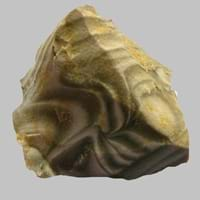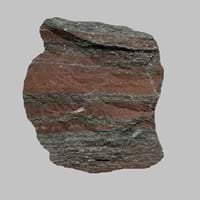Flint and Jaspillite
Definition
Definition
Flint is a hard type of sedimentary rock that produces a small piece of burning material when hit by steel
Jaspillite is an iron rich chemically formed rock which is common in banded iron formation rocks
History
Origin
Unknown
Western Australia, Minnesota
Discoverer
Unknown
Unknown
Etymology
From Old English flint - a type of rock mainly known for high hardness and for giving off sparks when struck
From Jaspilite (Mineral), a compact siliceous rock which resembles jasper
Class
Sedimentary Rocks
Sedimentary Rocks
Sub-Class
Durable Rock, Hard Rock
Durable Rock, Soft Rock
Family
Group
Not Applicable
Not Applicable
Other Categories
Fine Grained Rock, Opaque Rock
Coarse Grained Rock, Opaque Rock
Texture
Texture
Banded, Rough
Banded, Trellis
Color
Black, Brown, Green, Grey, Red, White
Red, Reddish Brown
Maintenance
Less
Less
Durability
Durable
Durable
Water Resistant
Yes
No
Scratch Resistant
Yes
No
Stain Resistant
Yes
No
Wind Resistant
Yes
No
Acid Resistant
No
No
Appearance
Glassy or Pearly
Banded and Glassy
Uses
Architecture
Interior Uses
Decorative Aggregates, Homes, Interior Decoration
Decorative Aggregates, Interior Decoration
Exterior Uses
As Building Stone, As Facing Stone, Garden Decoration, Office Buildings, Paving Stone
As Facing Stone, Garden Decoration, Paving Stone
Other Architectural Uses
Curbing
Curbing
Industry
Construction Industry
Arrowheads, Cutting Tool, Spear Points
As a Flux in the Production of Steel and Pig Iron, As a Sintering Agent in Steel Industry to process Iron Ore, As Dimension Stone, Cement Manufacture, for Road Aggregate, Making natural cement, Manufacture of Magnesium and Dolomite Refractories
Medical Industry
Not Yet Used
Not Yet Used
Antiquity Uses
Artifacts
Artifacts, Jewellery, Monuments
Other Uses
Commercial Uses
Creating Artwork, Gemstone, In fire-starting tools, Manufacture of tools, Metallurgical Flux, Jewelry, To ignite fire, Used in flintlock firearms
Creating Artwork, Jewelry
Types
Types
Not Available
Algoma-type , Lake Superior-type and Superior-type
Features
Clasts are smooth to touch, Easily splits into thin plates, Has High structural resistance against erosion and climate
Is one of the oldest rock
Archaeological Significance
Monuments
Not Yet Used
Used
Famous Monuments
Not Applicable
Data Not Available
Sculpture
Not Yet Used
Not Yet Used
Famous Sculptures
Not Applicable
Not Applicable
Pictographs
Not Used
Used
Petroglyphs
Not Used
Used
Figurines
Not Yet Used
Not Yet Used
Fossils
Present
Present
Formation
Formation
Flint is formed by the decomposition and compaction of various organisms such as sponges and diatoms under the water.
Jaspillite is a type of sedimentary rock which is formed by the compaction and sedimentation of pieces of broken or weathered rocks and minerals.
Composition
Mineral Content
Silicon
Coesite, Quartz, Sand
Compound Content
Silicon Dioxide
Fe, Iron(III) Oxide, Silicon Dioxide
Transformation
Metamorphism
No
No
Types of Metamorphism
Not Applicable
Not Applicable
Weathering
No
Yes
Types of Weathering
Not Applicable
Biological Weathering, Chemical Weathering
Erosion
Yes
Yes
Types of Erosion
Chemical Erosion, Coastal Erosion, Water Erosion
Chemical Erosion, Coastal Erosion
Properties
Physical Properties
Hardness
7
3
Grain Size
Very fine-grained
Large and Coarse Grained
Fracture
Conchoidal
Conchoidal
Streak
White
White
Porosity
Highly Porous
Very Less Porous
Luster
Vitreous
Earthy
Compressive Strength
450.00 N/mm2
1
230.00 N/mm2
6
Cleavage
Non-Existent
Imperfect
Toughness
1.5
Not Available
Specific Gravity
2.5-2.8
5.0-5.3
Transparency
Translucent to Opaque
Translucent to Opaque
Density
2.7-2.71 g/cm3
0-5.7 g/cm3
Thermal Properties
Specific Heat Capacity
0.74 kJ/Kg K
19
3.20 kJ/Kg K
1
Resistance
Heat Resistant, Impact Resistant, Pressure Resistant, Wear Resistant
Heat Resistant, Impact Resistant, Wear Resistant
Reserves
Deposits in Eastern Continents
Asia
Azerbaijan, China, Russia
Russia
Africa
Not Yet Found
Not Yet Found
Europe
Austria, Belgium, Cyprus, Denmark, France, Germany, Italy, Malta, Netherlands, Poland, Portugal, Romania, Spain, Sweden, Switzerland, Turkey, Ukraine, United Kingdom
Ukraine
Others
Not Yet Found
Not Yet Found
Deposits in Western Continents
North America
USA
Canada, USA
South America
Bolivia
Brazil
Deposits in Oceania Continent
Australia
New Zealand, South Australia
Western Australia
All about Flint and Jaspillite Properties
Know all about Flint and Jaspillite properties here. All properties of rocks are important as they define the type of rock and its application. Flint and Jaspillite belong to Sedimentary Rocks.Texture of Flint is Banded, Rough whereas that of Jaspillite is Banded, Trellis. Flint appears Glassy or Pearly and Jaspillite appears Banded and Glassy. The luster of Flint is vitreous while that of Jaspillite is earthy. Flint is available in black, brown, green, grey, red, white colors whereas Jaspillite is available in red, reddish brown colors. The commercial uses of Flint and Jaspillite are creating artwork, gemstone, in fire-starting tools, manufacture of tools, metallurgical flux, jewelry, to ignite fire, used in flintlock firearms.
|
||
|
||
|










